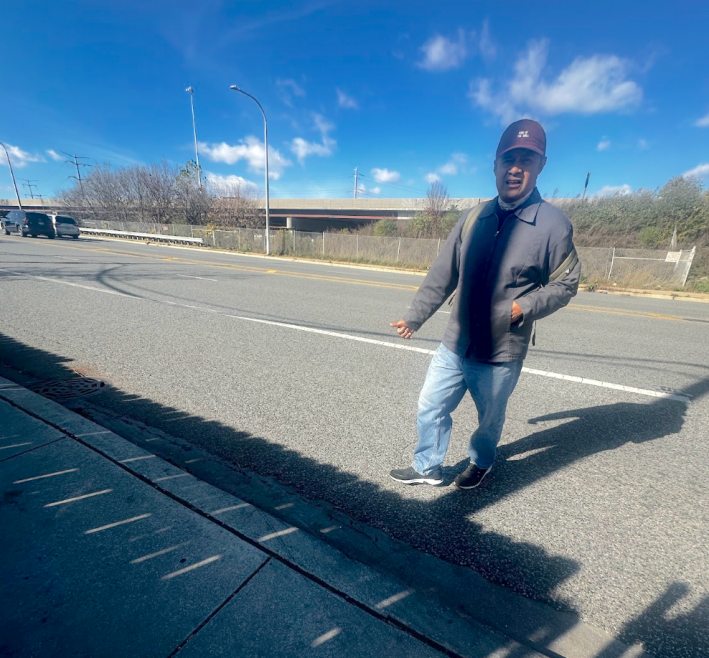
By Victoria Malis
With seven lanes of car traffic and narrow sidewalks, the Archer Avenue bridge over Bubbly Creek, basically located at the intersection of Bridgeport, Pilsen, and McKinley Park, isn't anyone’s idea of an idyllic walk or bike ride. Yet many local residents take this bridge multiple times a week: to access the Ashland Orange Line station, and businesses like Mariano's supermarket and Blink Fitness gym.

Bridgeport residents take Archer Avenue Bridge to get groceries, go to the gym or reach the CTA. Image: Victoria Malis via Google Maps
"Lots of people were raised in suburbs where they had to drive everywhere," said Mary Lou Lopez, a long-time Bridgeport resident and advocate for a pedestrian-friendly Archer bridge. "They hear that you don't have to drive everywhere in the city. But then these people move to the city, and it turns out they still have to drive everywhere."
Lopez and another Bridgeport resident, Kristen Larson, decided to take matters into their own hands. The duo measured the sidewalks, downloaded crash data from the Chicago Data Portal and started collecting community feedback at playgrounds. Eventually, they scheduled meetings with local leaders State Rep. Theresa Mah (D-24th) and Ald. Nicole Lee (11th) to secure support and present a united front in conversations with the Chicago and Illinois transportation departments.
Larson and Lopez proposed two possible solutions. One would be the construction of a new bike-pedestrian bridge over Bubbly Creek. The other, probably less expensive, alternative is to convert two of the many mixed-traffic lanes on the Archer bridge to make room for widening the sidewalks and adding protected bike lanes. Lopez sees this initiative as part of a wider "reclaiming of the streets" community movement.
Any project that would improve safety on the Archer bridge comes with additional complexities. That stretch of Archer is under Illinois Department of Transportation jurisdiction even though the Chicago Department of Transportation maintains and operates it. In such cases, IDOT and CDOT review and finalize design plans jointly, and then CDOT implements the changes.
The city agency has indicated that they'd be onboard with safety upgrades to the Archer bridge. "CDOT is actively working to improve safety and comfort for everyone traveling along the corridor by reducing dangerous speeding and enhancing conditions for people walking," said spokesperson Erica Schroeder.
CDOT is already planning other safety upgrades on Archer in this part of town. In spring 2025, the department will install corner bump-outs and curb extensions on Archer at Leavitt Street (2200 W.), about a mile southwest of the bridge. And earlier this year, they announced planned safety upgrades near Archer's intersection with Kedzie Avenue (3200 W.), located 2.7 miles from the Bubbly Creek span.

"Additional safety measures are being developed for other parts of the corridor, including the section between Ashland Avenue [1600 W.] and Lock Street [1500 W.]," Schroeder said. That 0.3 mile stretch straddles the bridge.
Built in 1963 under Mayor Richard J. Daley, the creek crossing has 29-inch-wide sidewalk segments, which is three inches narrower than the Americans with Disabilities Act standard.

According to the Chicago Data Portal, since 2021 there have been at least two fatal and six non-fatal crashes on the bridge that involved pedestrians. In Bridgeport, where kids under 18 make up 23 percent of the population, these numbers aren’t taken lightly by parents.
Father of seven and longtime Bridgeport resident Cesar Perez, 55, said he only walks the bridge when his car is being repaired. Perez recommended to his children that they take the bus whenever they travel from Pilsen and the North Side to visit him. He explained that the bridge sidewalk is so narrow, anytime he's walking on it and encounters a person with a stroller, in a wheelchair, or on a bike using the walkway, he steps into the street to avoid a conflict, which is especially unsafe at night.

Azal Ily, 44, has lived in Bridgeport for over 13 years. A car owner, he said he still walks the bridge every day to get to the local gym. He added that he often notices is speeding motorists driving well over the 30 mph speed limit.
"A seven-lane bridge encourages speeding," Larson said “Increasing the width of sidewalks to actually be ADA-compliant and adding bike lanes creates an opportunity for the space to say that we prioritize people and communities rather than cars."
Rep. Mah voiced her support of Lopez and Larson’s advocacy efforts in a written statement. "As a legislator who has always championed efforts to make our streets more pedestrian- and bike-friendly, I am fully in support of their project, and was able to offer a few suggestions and action items that will help us all reach our goal for safer and more accessible streets," the statement reads.
Lopez and Larson are exploring different routes to get more community input. The next step they are considering is putting QR-codes on the bridge with instructions in English, Spanish and Chinese, which will lead to a petition or an open letter for a safer bridge.
IDOT has historically prioritized moving drivers through Chicago quickly, over creating safe streets for local residents. Let's hope that this campaign succeeds in persuading the State to do the right thing.

Did you appreciate this post? Please consider making a tax-deductible donation, to help keep Streetsblog Chicago's sustainable transportation news and advocacy articles paywall-free.





